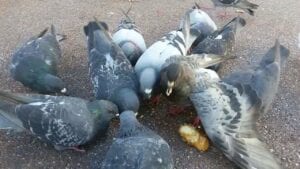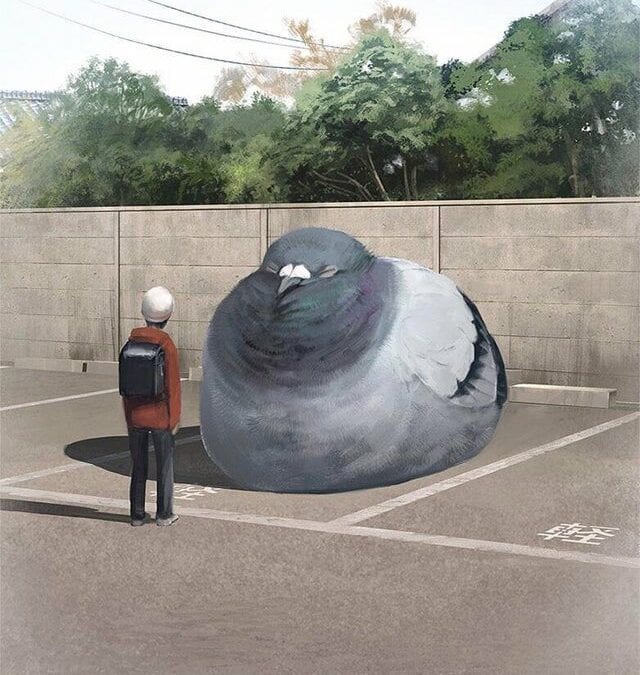
by Pigeon Patrol | Jul 12, 2021 | Bird Deterrent Products, Bird Law, Bird Netting, Bird Spikes, Columbidae, Doves
ST. PAUL, Minn.–Pounded and strained by heavy traffic and weakened by missing bolts and cracking steel, the failed interstate bridge over the Mississippi River also faced a less obvious enemy: Birds, specifically pigeons.
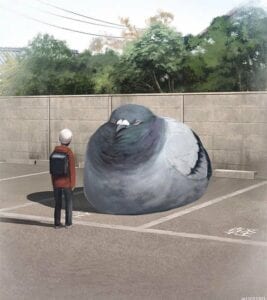
Inspectors began documenting the build-up of pigeon dung on the span near downtown Minneapolis two decades ago.
Experts say the corrosive guano deposited all over the bridge’s framework helped the steel beams rust faster.
Although investigators have yet to identify the cause of the bridge’s Aug. 1 collapse, which killed at least 13 people and injured about 100, the pigeon problem is one of many factors that dogged the structure.
“There is a coating of pigeon dung on steel with nest and heavy build-up on the inside hollow box sections,” inspectors wrote in a 1987-1989 report.
In 1996, screens were installed over openings in the bridge’s beams to keep pigeons from nesting there, but that didn’t prevent the build-up of droppings elsewhere.
Pigeon droppings contain ammonia and acids, said chemist Neal Langerman, of the American Chemical Society. If the dung isn’t washed away, it dries out and turns into a concentrated salt. When water gets in and combines with the salt and ammonia, it creates small electrochemical reactions that rust the steel underneath.
“Every time you get a little bit of moisture there, you wind up having a little bit of electrochemistry occurring and you wind up with corrosion,” said Langerman. “Over a long term, it might in fact cause structural weaknesses.”
Langerman emphasized that he wasn’t saying absolutely that pigeon dung factored into the collapse of the bridge, but the problem is familiar to bridge inspectors everywhere.
The Colorado Department of Transportation spent so much time cleaning pigeon manure off bridges that it’s researching new ways to keep the birds away from its spans.
Source
Pigeon Patrol Products & Services is the leading manufacturer and distributor of bird deterrent (control) products in Canada. Pigeon Patrol products have solved pest bird problems in industrial, commercial, and residential settings since 2000, by using safe and humane bird deterrents with only bird and animal friendly solutions. At Pigeon Patrol, we manufacture and offer a variety of bird deterrents, ranging from Ultra-flex Bird Spikes with UV protection, Bird Netting, 4-S Bird Gel and the best Ultrasonic and audible sound devices on the market today.
Voted Best Canadian wholesaler for Bird Deterrent products ten years in a row.
Contact us at 1- 877– 4– NO-BIRD, (604) 585-9279 or visit our website at www.pigeonpatrol.ca
Pigeon/Pigeon Patrol / Pigeons Roosting / Vancouver Pigeon Control /Bird Spikes / Bird Control / Bird Deterrent / Pigeon Deterrent? Surrey Pigeon Control / Pest /Seagull deterrent / Vancouver Pigeon Blog / Birds Inside Home / Pigeons in the cities / Ice Pigeons/ What to do about pigeons/ sparrows , Damage by Sparrows, How To Keep Raccoons Away, Why Are Raccoons Considered Pests/ De-fence / Pigeon Nesting/ Bird Droppings / Pigeon Dropping/ woodpecker control/ Professional Bird Control Company/ Keep The Birds Away/ Birds/rats/ seagull/pigeon/woodpecker/ dove/sparrow/pidgeon control/pidgeon problem/ pidgeon control/flying rats/ pigeon Problems/ bird netting/bird gel/bird spray/bird nails/ bird guard
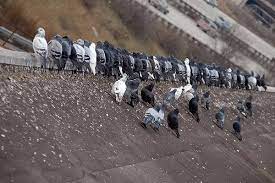
by Pigeon Patrol | Jul 5, 2021 | MBCA, pet bird, Pigeon Control, Pigeon Droppings, Pigeon Patrol's Services, Pigeon Predators
Heavily armed shock troops took to the streets of Downtown, police officers barked at pedestrians to take cover and Pittsburgh’s mayor donned a bulletproof vest yesterday afternoon as reports of a sniper in the heart of the business district triggered a massive police response and paralyzed both commerce and traffic.
Several nervous callers to 911 had described a man with a bushy beard carrying a rifle with a scope and pointing it out the windows of a building in the 500 block of Penn Avenue.
Police closed off streets. Inbound lanes of the Fort Pitt Bridge were closed to traffic, as were ramps leading to Downtown from the Fort Duquesne Bridge. A Port Authority Police officer armed with an AR-15 rifle stood guard at Penn Avenue and Stanwix Street.
It was a surreal incident, a surreal response and, fittingly, a surreal ending.
There was no sniper after all, only a maintenance man at the Pittsburgh Allegheny County Thermal plant shooting at pigeons inside the 10-story facility with a pellet rifle.
Police declined to identify the man. But PACT president Robert Fazio said he was Richard Wills, an “excellent” longtime employee who has worked single-handedly for several years to eradicate the plant’s pigeon problem after poison and plastic owls proved unsuccessful. PACT provides steam heat for buildings throughout Downtown.
When police discovered that tidbit of information, they also learned another. Despite the rapid response and overwhelming police presence, the worker, a Fayette County resident, had quietly left, possibly oblivious to the uproar he had caused.
Mr. Wills could not be reached for comment last night.
Police spokeswoman Tammy Ewin said it was unlikely the man would be arrested. The only charge likely to stem from the incident could be a citation if it were determined he fired the gun illegally inside the city limits, Ms. Ewin said.
Chief Dominic J. Costa, who was Downtown along with Mayor Bob O’Connor and other top local officials, said merely carrying a pellet rifle Downtown might not be against the law. However, he added, it flew in the face of common sense.
“Look at the alarm he caused. Look at all the inconvenience he caused,” Chief Costa said.
Until police determined roughly two hours into the incident that there was no imminent danger, they took no chances.
The event began around 1:05 p.m., apparently after a witness saw a man with a rifle inside a building on Penn Avenue. Then a police dispatcher broadcast information about a gunman with a rifle and a scope on the fourth floor of a building at Penn and Cecil Way, an alley running from Penn to Fort Duquesne Boulevard. Another dispatch had the man wearing some type of light strapped to his shoulder.
Officers shut Penn Avenue, Fort Duquesne Boulevard and Liberty Avenue from Stanwix to Sixth streets and posted officers at the intersections.
“Folks, you need to either move to the right or the left,” bellowed one motorcycle officer to a group of pedestrians on Stanwix Street. “This guy has a high-powered rifle.”
About 100 Highmark Life and Casualty employees were told to keep clear of the windows of their floor in 515 Penn Ave., which faced the building at 525 Penn Ave., where the incident was taking place.
They remained in the building for two hours, tracking the unfolding events on the Internet, television and phone calls from the outside, said staffer Carol Hunter.
The shutdown paralyzed some businesses both inside and outside the taped-off police perimeter. One exception was the Sixth Penn bistro, where the five-person kitchen crew remained busy hustling out orders of meatloaf, crabcake and Reuben sandwiches all afternoon.
“Customers were enjoying hanging out,” said fry cook Chris Eggleton, 32. “People took it as an extended lunch at the expense of a sniper.”
At the Fifth Avenue Beanery coffee shop, customers presumably were “just sitting at the tables or walking back and forth, talking on their cell phones,” said Manager Mary Ann Keating. “People were more frustrated about what was going on. They wanted out and they weren’t allowed out.”
For a time, police had trouble locating the right building. Adding to the confusion were later dispatches that the suspect might be walking away carrying a duffel bag or a backpack.
Eventually, police focused on the PACT complex, two buildings along Fort Duquesne Boulevard and Cecil Way that share a common wall.
As surveillance continued, police swarmed Downtown in droves. Unmarked cars pulled up, one after the other, as members of the Special Emergency Response Team exited, donned body armor and unloaded heavy weapons. Snipers took up positions.
A state police helicopter whirred overhead. The bomb squad arrived. Allegheny County Sheriff Peter R. DeFazio and Chief Executive Dan Onorato showed up.
And Mr. O’Connor, whose wife, Judy, was at work in the hot zone, ran across Penn Avenue shielded by his bodyguard, Officer Joseph Ryczaj, to check on her.
Authorities established a command post in the lobby of Fifth Avenue Place, where a police robot rolled over the lobby floor.

“It’s kind of crazy,” said Tara Bingaman, 28, of North Huntingdon, a student at Point Park University who wandered over to Stanwix Street to witness the hubbub.
Around 2:20 p.m., SERT officers marched out of Fifth Avenue Place. Mr. O’Connor, whose white hair stood in contrast to the officers’ black outfits, stood at the end of their line. The officers made their way around the corner onto Penn and down Cecil Way.
Eventually, they entered the PACT building shortly before 3 p.m. and found a foreman who told them the description of the man with a gun matched that of an employee who shoots pigeons with a pellet rifle and a scope.
Mr. Fazio said Mr. Wills used his own pellet rifle — which he stores at the plant — to clear out pigeons who roost in the building’s rafters and rain droppings down on the machinery.
“We do have an internal building pigeon problem. The pigeons come into our building and from time to time one of our employees has used a pellet rifle to get rid of pigeons inside our building only,” Mr. Fazio said.
Patrons at Caffe Amante, a restaurant on the second floor of Fifth Avenue Place, had been finishing lunches or heading back to work when police poured into the area and ordered the building shut down. So they headed back to the restaurant, which overlooks Penn Avenue and Stanwix Street, to cluster around the television and watch news reports about the situation unfolding on the streets around them.
“It was confusing and more than a little aggravating,” manager Debbie Doucette said. “Now that it turns out to be a pellet gun, I’m really aggravated. We were all held up for two hours for pigeons and pellet guns.”
Source
Pigeon Patrol Products & Services is the leading manufacturer and distributor of bird deterrent (control) products in Canada. Pigeon Patrol products have solved pest bird problems in industrial, commercial, and residential settings since 2000, by using safe and humane bird deterrents with only bird and animal friendly solutions. At Pigeon Patrol, we manufacture and offer a variety of bird deterrents, ranging from Ultra-flex Bird Spikes with UV protection, Bird Netting, 4-S Bird Gel and the best Ultrasonic and audible sound devices on the market today.
Voted Best Canadian wholesaler for Bird Deterrent products ten years in a row.
Contact us at 1- 877– 4– NO-BIRD, (604) 585-9279 or visit our website at www.pigeonpatrol.ca
Pigeon/Pigeon Patrol / Pigeons Roosting / Vancouver Pigeon Control /Bird Spikes / Bird Control / Bird Deterrent / Pigeon Deterrent? Surrey Pigeon Control / Pest /Seagull deterrent / Vancouver Pigeon Blog / Birds Inside Home / Pigeons in the cities / Ice Pigeons/ What to do about pigeons/ sparrows , Damage by Sparrows, How To Keep Raccoons Away, Why Are Raccoons Considered Pests/ De-fence / Pigeon Nesting/ Bird Droppings / Pigeon Dropping/ woodpecker control/ Professional Bird Control Company/ Keep The Birds Away/ Birds/rats/ seagull/pigeon/woodpecker/ dove/sparrow/pidgeon control/pidgeon problem/ pidgeon control/flying rats/ pigeon Problems/ bird netting/bird gel/bird spray/bird nails/ bird guard
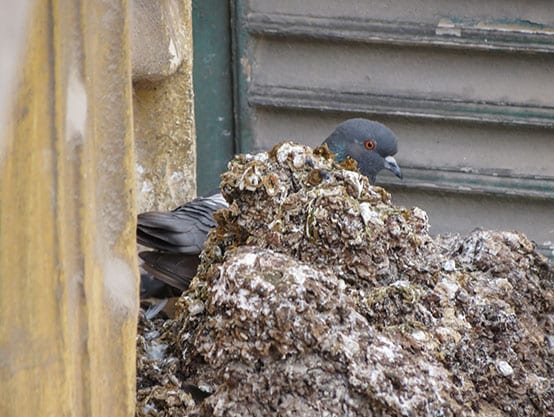
by Pigeon Patrol | Jul 5, 2021 | pet bird, Pigeon Control, Pigeon Droppings, Pigeon Patrol's Services, Pigeon Predators
What Is Bird Flu?
Bird flu, or avian influenza, is a viral infection spread from bird to bird. The most common kind of bird flu is the H5N1 strain. It’s mostly a threat to birds and doesn’t spread easily among people, but there was a major outbreak of bird flu in people in 2014. The very few cases of human-to-human transmission were among people with exceptionally close contact, such as a mother who caught the virus while caring for their sick infant.
Migrating water fowl — most notably wild ducks — are the natural carriers of bird flu viruses. It’s suspected that infection can spread from wild fowl to domestic poultry.
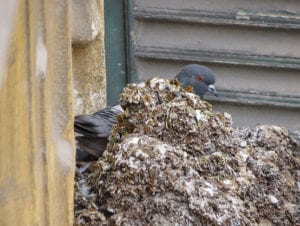
a pigeon bird standing by guano manure
How Do Humans Get Bird Flu?
People catch bird flu by close contact with birds or bird droppings.
In the 2014 outbreak, some people caught H5N1 from cleaning or plucking infected birds. There were reports in China of infection via inhalation of aerosolized materials in live bird markets. It’s also possible that some people were infected after swimming or bathing in water contaminated with the droppings of infected birds. And some infections have occurred in people who handle fighting cocks.
People don’t catch the virus from eating fully cooked chicken or eggs.
There were a few cases where one infected person caught the bird flu virus from another person, but only after close personal contact.
In Indonesia in 2006, bird flu spread to eight members of one family. Seven of them died. It’s not clear exactly how this happened. Family members likely had similar contacts with infected birds. They may also have shared genes that made them particularly susceptible to the virus. However, casual contact does not seem to be involved.
Has Bird Flu Been Seen in the U.S.?
Various strains of bird flu pop up in U.S. poultry from time to time. When they do, all affected poultry flocks are culled.
For example, in 2004, a highly dangerous bird flu strain appeared in a Texas chicken flock. The outbreak involved an H5N2 virus (not the H5N1 bird flu). By April 2004, the outbreak had been eradicated. No human infections were detected.
What Are the Symptoms of Bird Flu in People?
Bird flu symptoms in people can vary. It may start out with normal flu-like symptoms. Sometimes, this can worsen to become a severe respiratory disease that can be fatal.
In February 2005, researchers in Vietnam reported human cases of bird flu in which the virus infected the brain and digestive tract of two children. Both died. These cases show that bird flu in humans may not always look like typical cases of flu.
Is There a Bird Flu Vaccine?
Yes. The FDA approved the first vaccine to prevent human infection with one strain of the bird flu in 2007. But it’s not been made commercially available to the general public. The U.S. government purchased the vaccine in case it needed to be distributed by public health officials.
Is There a Treatment for Bird Flu?
The flu drugs oseltamivir (Tamiflu), peramivir (Rapivab), or zanamivir (Relenza) may help treat bird flu in people, although more studies are needed. These drugs must be given soon after symptoms appear.
Source
Pigeon Patrol Products & Services is the leading manufacturer and distributor of bird deterrent (control) products in Canada. Pigeon Patrol products have solved pest bird problems in industrial, commercial, and residential settings since 2000, by using safe and humane bird deterrents with only bird and animal friendly solutions. At Pigeon Patrol, we manufacture and offer a variety of bird deterrents, ranging from Ultra-flex Bird Spikes with UV protection, Bird Netting, 4-S Bird Gel and the best Ultrasonic and audible sound devices on the market today.
Voted Best Canadian wholesaler for Bird Deterrent products ten years in a row.
Contact us at 1- 877– 4– NO-BIRD, (604) 585-9279 or visit our website at www.pigeonpatrol.ca
Pigeon/Pigeon Patrol / Pigeons Roosting / Vancouver Pigeon Control /Bird Spikes / Bird Control / Bird Deterrent / Pigeon Deterrent? Surrey Pigeon Control / Pest /Seagull deterrent / Vancouver Pigeon Blog / Birds Inside Home / Pigeons in the cities / Ice Pigeons/ What to do about pigeons/ sparrows , Damage by Sparrows, How To Keep Raccoons Away, Why Are Raccoons Considered Pests/ De-fence / Pigeon Nesting/ Bird Droppings / Pigeon Dropping/ woodpecker control/ Professional Bird Control Company/ Keep The Birds Away/ Birds/rats/ seagull/pigeon/woodpecker/ dove/sparrow/pidgeon control/pidgeon problem/ pidgeon control/flying rats/ pigeon Problems/ bird netting/bird gel/bird spray/bird nails/ bird guard
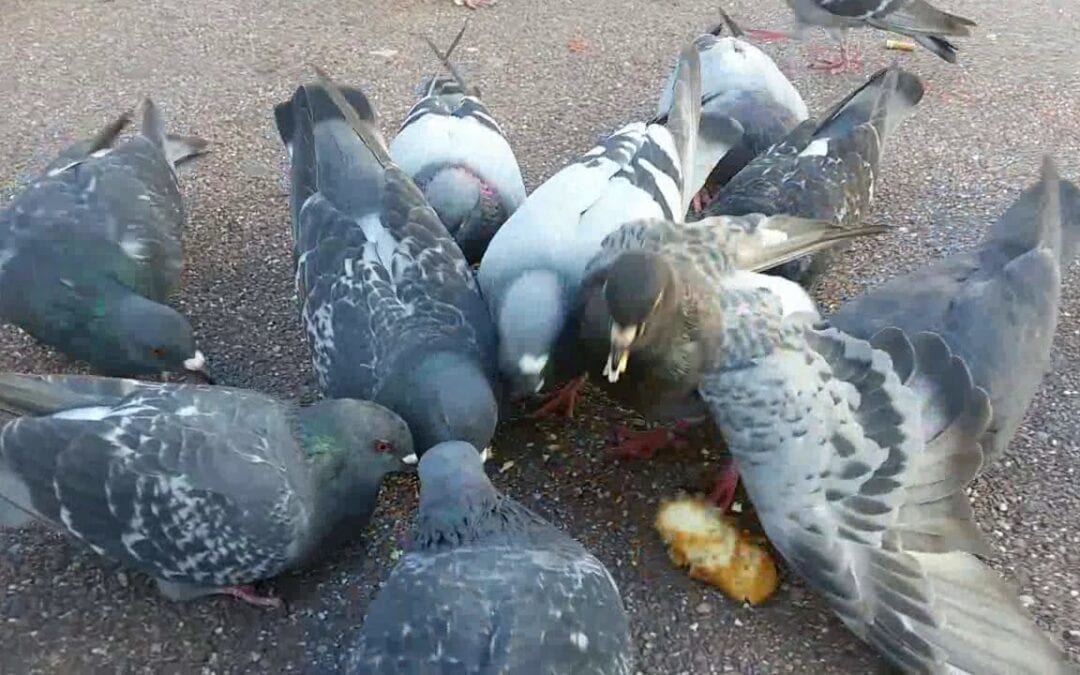
by Pigeon Patrol | Jul 5, 2021 | Pigeon Predators, Pigeon Spikes, Pigeons, Pigeons in the News, Raccoons, Sparrows, UltraSonic Bird Control
If you saw Mary Poppins as a child and remember hearing ‘Feed the birds, tuppins a bag’ you probably thought that feeding the pigeons was a rather altruistic activity. Think again. ‘Pigeons are degrading the city,’ says Florence’s Environmental Assessor, Claudio Del Lungo, who recently passed an ordinance prohibiting the feeding of street birds. Fines are 50 Euro for anyone who feeds pigeons in the plaza or ducks along the Arno. The ordinance was issued in response to complaints from citizens about the worsening pigeon problem. According to Del Lungo, they attract rodents and insects, deteriorate hygiene conditions and damage buildings and monuments.
As for the ducks, Del Lungo worries about their diet. He argues that people tend to overfeed ducks, perhaps killing them as a result. As is true for pigeons, food thrown into the Arno also attracts animals that will only cause the river to become dirty and pest-ridden.
This ordinance will be adopted by other cities in Italy as well. The objective is to cut costs related to sterilization, which is often ineffective. There are, however, four exceptions to the newly passed ordinance. They are: feeding grain to wild birds in agricultural areas; in private areas using bird feeders; under community administration; or while the birds are being monitored with ASL staff or other sanitary personnel—but never, ever in the piazza.
Source
Pigeon Patrol Products & Services is the leading manufacturer and distributor of bird deterrent (control) products in Canada. Pigeon Patrol products have solved pest bird problems in industrial, commercial, and residential settings since 2000, by using safe and humane bird deterrents with only bird and animal friendly solutions. At Pigeon Patrol, we manufacture and offer a variety of bird deterrents, ranging from Ultra-flex Bird Spikes with UV protection, Bird Netting, 4-S Bird Gel and the best Ultrasonic and audible sound devices on the market today.
Voted Best Canadian wholesaler for Bird Deterrent products ten years in a row.
Contact us at 1- 877– 4– NO-BIRD, (604) 585-9279 or visit our website at www.pigeonpatrol.ca
Pigeon/Pigeon Patrol / Pigeons Roosting / Vancouver Pigeon Control /Bird Spikes / Bird Control / Bird Deterrent / Pigeon Deterrent? Surrey Pigeon Control / Pest /Seagull deterrent / Vancouver Pigeon Blog / Birds Inside Home / Pigeons in the cities / Ice Pigeons/ What to do about pigeons/ sparrows , Damage by Sparrows, How To Keep Raccoons Away, Why Are Raccoons Considered Pests/ De-fence / Pigeon Nesting/ Bird Droppings / Pigeon Dropping/ woodpecker control/ Professional Bird Control Company/ Keep The Birds Away/ Birds/rats/ seagull/pigeon/woodpecker/ dove/sparrow/pidgeon control/pidgeon problem/ pidgeon control/flying rats/ pigeon Problems/ bird netting/bird gel/bird spray/bird nails/ bird guard
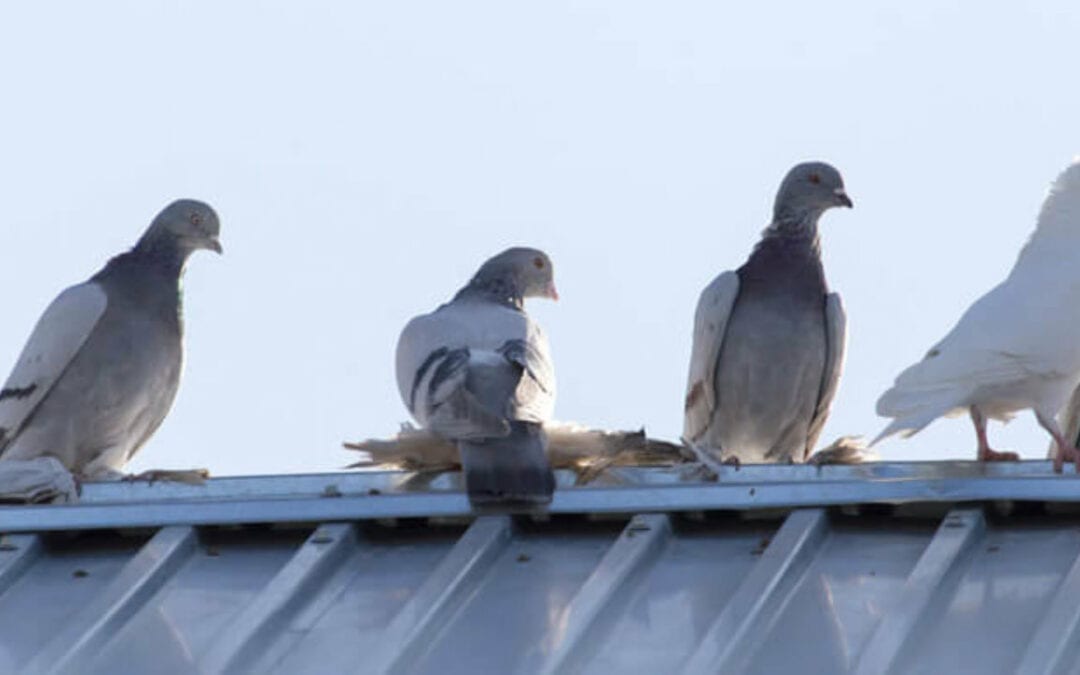
by Pigeon Patrol | Jul 5, 2021 | 4-S Gel Bird repellent, Animal Deterrent Products, Bird Deterrent Products, Bird Law, Bird Netting, Bird Spikes
A little experiment: What comes to mind when you hear the word “dove”?
Intimations of peace? The promise of hope after long hardship, à la Noah releasing a snow-white bird to gauge the waters of the flood? A kick-ass ice cream bar? Whatever the image, the association is likely positive. Beatific, even.
Now try another word. “Pigeon.”
If you’re like most people — and especially if you’re like most city dwellers — you probably get a bit skeeved out just hearing the word. Pigeons? They might not be vermin — not exactly — but they aren’t too far up the ladder, either. They eat trash. They crap everywhere. Stupid. Filthy. Rats with wings. Right? Sorry, but not quite. In fact, not even close. And thanks to Andrew Blechman’s consistently engaging and surprising new book, “Pigeons,” the seemingly dull, unlovely members of the Columbidae family — or, rather, their idiosyncratic and intensely loyal human proponents — now have a handy arsenal of lively anecdotes and plain old facts (heads up, wisenheimers: Pigeons are doves) with which to defend their long-maligned feathered friends.
Along the way, Blechman takes pains to chronicle the views of people for whom pigeons are, at best, a nuisance and, at worst, a plague. He spends a cold, taxing day in rural Pennsylvania among a community of men, women and children who enthusiastically and unapologetically shoot pigeons for sport, for food and even for charity. He chats with the owner of a South Carolina squab-processing plant for whom the birds are nothing more than meat divinely destined for ovens, frying pans and human gullets. (“All he cares about,” Blechman writes, “are breasts, because that’s where the meat is. ‘I want nice, well-rounded ones,’ he tells me. ‘I want big breasts.'”) And, evidently without having to search too far, Blechman finds and dutifully quotes those who, for reasons as numerous as bread crumbs in St. Mark’s Square, simply despise the red-legged head-bobbers that have learned to live (and, more universally than their human counterparts, thrive) amid the chaos of modern metropolises.

But despite his fair and balanced reporting on the many detractors of, as his book’s subtitle has it, “The World’s Most Revered and Reviled Bird,” make no mistake — Blechman himself is a Columbidae family man. While he was, by his own admission, neither anti- nor pro-pigeon when he began the peripatetic journey traced in the book, something clearly happened during his wanderings through the variegated, far-flung worlds of pigeonistas. Yes, the author dutifully records the myriad arguments for the bird’s obliteration. Sure, he eats fried pigeon, and enjoys it. Admittedly, he readies, aims and fires a shotgun at pigeons, and experiences the thrill of the hunt — or, more exactly, the thrill of standing still and blasting away at birds released from spring-loaded traps. But almost before the reader has settled in and begun to enjoy Blechman’s disarming, conversational style (“Some people like pigeons. But pigeons also piss a lot of people off”), the author’s enthusiasm for his subject starts flying right off the page. One almost pictures him beating imaginary wings as he expounds on the pigeon’s mind-boggling physical attributes and capabilities:
“With hollow bones containing reservoirs of oxygen, a tapered fuselage, giant breast muscles that account for one-third of its body mass, and an ability to function indefinitely without sleep, the rock dove [as many ornithologists have begun referring to the bird] is a feathered rocket built for speed and endurance. If an average up-and-down of the wing takes the bird three feet, then a racer is making roughly 900,000 of those motions during a long-distance race, while maintaining 600 heartbeats per minute — triple its resting rate. The rock dove can reach peak velocity in seconds and maintain it for hours on end. One pigeon was recorded flying for several hours at 110 mph — an Olympian feat by any measure.”
That Blechman repeats, with only slight variations, this litany of athletic gifts throughout the book is one of the few aspects of the tale that grows old. We get it! Pigeons are incredibly fast fliers that can remain on the wing at top speed for hours on end on the avian equivalent of fumes. Is there really anything more of interest to say about the animal? What else has it got? And does the creature actually warrant writing, and reading, a whole book?
Pigeons, it turns out, have lived closely with humans, in a perpetually evolving relationship — first as a handy and docile source of protein, then as an incomparably fast means of transferring information and, finally, as a focus of sport (racing and shooting) and a pastime (show breeding) — for perhaps 10,000 years. They’ve served as symbols of fertility, peace and renewal in religions from Christianity and Judaism to Greek, Babylonian and other Mediterranean and Middle Eastern cults and creeds, while practitioners of yoga have long invoked the bird’s winged shape while assuming poses like the One-Legged King Pigeon.
For millennia, rock doves helped lost seafarers point their crafts toward land when lost, for even though the bird “often dwells on coastal cliffs, it has an aversion to large bodies of water and always flies inland in search of food. A bird released from a ship will quickly orient itself to land, and early sailors undoubtedly followed suit.”
Of course, the bird’s astonishing homing skills have been used for as long as, if not longer than, recorded history to carry messages of victory (and defeat) in war, announcements of the ascension of new kings and pharaohs to the throne, and even warnings of floods along the Nile. Underground coops discovered in Israel, dating from the time of King Solomon, held an estimated 120,000 pigeons — at least a few of which were, presumably, used for purposes other than keeping David and Bathsheba’s son and his friends readily supplied with squab.
And then there’s the tale of the creation of one of the world’s largest news companies. It all started when a failed German businessman named Israel Beer Josaphat hit upon the idea of tying tiny little bags stuffed with news and stock market prices beneath the wings of homing pigeons flown between Brussels and Aachen, Germany. The train between the cities took eight hours, the birds less than two. Josaphat ultimately changed his name to Julius Reuter and created a news-gathering empire founded on (or beneath) the wings of rock doves.
But as edifying as these historical tidbits might be, and as much about the rock dove as the book might appear to be, the story of “Pigeons” is, ultimately, one of how people respond to the bird. In the best sense, Blechman’s book reads like a series of entertaining, eye-opening magazine pieces held together by the sinews, feathers and strong, hollow bones of the rock dove. Like so many of the surprisingly enthralling books written in recent years about one discrete, at-first-glance vapid topic — Mark Kurlansky’s “Cod,” Charles Seife’s “Zero: The Biography of a Dangerous Idea,” and innumerable others — “Pigeons” manages to illuminate not merely the ostensible subject of the book, but also something of the endearing, repellent, heroic and dastardly nature of that most bizarre of breeds, Homo sapiens.
Blechman has a shrewd eye and an ear nicely attuned to the peculiarities that reveal personality, and the human characters populating the pages of “Pigeons” are wonderfully and sympathetically drawn. From the friendly, unassuming pigeon breeders at the Grand Nationals competition held at a Lancaster, Pa., hotel, to the clearly obsessed trainers and owners of racing pigeons in the Bronx and rural England and beyond, to the happy, driven rescuer and champion of rock doves who lives in a squalid home in Arizona literally dripping with not-quite-calcified pigeon shit, the pro-bird folks who pop up in “Pigeons” make avid cat and dog people seem, well, tame in comparison.
“Sweetie, a pigeon the size of a small turkey, is pacing back and forth on what used to be a Formica kitchen counter,” Blechman writes of a bird who makes her home with Dave Roth, the one-man rescue mission and Jerry Garcia look-alike of Phoenix, Ariz. “Roth nuzzles her. ‘That’s my girl. You’re such a sweetie, aren’t you?’ He turns to face me. ‘If everybody could experience this kind of a relationship with a bird, then we wouldn’t have all the problems we have today with the pigeon haters. Pigeons can be funny, animated, and loyal like a dog. You’d be amazed.'”
This kitchen counter encounter, which appears at just about the exact halfway point of the book, is emblematic of much that’s weird and humorous and even a little unsettling about Blechman’s tale. If you’re somehow still on the fence about pigeons until this point, you’ll probably fall hard and fast on either side once you’ve spent a little time with Dave Roth. (Of eating squab, Roth opines that it’s “like Jeffrey Dahmer eating your kid.” Roth, it’s worth noting, is a bachelor. And childless.)
Finally, as fate would have it, at pretty much the exact same time that Blechman’s book was hitting bookstores, several research studies found that (wait for it) pigeons are vastly more intelligent than anyone, even most pigeon fans, have given them credit for.
“Pigeons are no slouches,” said Robert G. Cook of Tufts University, coauthor of a study that found that pigeons can remember more than 1,000 individual images. Another study showed that pigeons evidently possess the ability to compare relationships — such as sameness or difference — rather than merely identifying distinct images or objects. Researchers claimed that the ability, previously observed and quantified only in humans and a handful of other higher mammals, is a form of analogous thinking — primitive, but nonetheless exceedingly rare in the animal kingdom.
Rats with wings? Affectionate companions? Idiotic pests? Miraculous navigators? Tasty eats? Blechman’s “Pigeons” flies in the face of conventional wisdom about a symbolically freighted bird that, if we thought about it at all, we thought we knew. Time to think again.
Source
Pigeon Patrol Products & Services is the leading manufacturer and distributor of bird deterrent (control) products in Canada. Pigeon Patrol products have solved pest bird problems in industrial, commercial, and residential settings since 2000, by using safe and humane bird deterrents with only bird and animal friendly solutions. At Pigeon Patrol, we manufacture and offer a variety of bird deterrents, ranging from Ultra-flex Bird Spikes with UV protection, Bird Netting, 4-S Bird Gel and the best Ultrasonic and audible sound devices on the market today.
Voted Best Canadian wholesaler for Bird Deterrent products ten years in a row.
Contact us at 1- 877– 4– NO-BIRD, (604) 585-9279 or visit our website at www.pigeonpatrol.ca
Pigeon/Pigeon Patrol / Pigeons Roosting / Vancouver Pigeon Control /Bird Spikes / Bird Control / Bird Deterrent / Pigeon Deterrent? Surrey Pigeon Control / Pest /Seagull deterrent / Vancouver Pigeon Blog / Birds Inside Home / Pigeons in the cities / Ice Pigeons/ What to do about pigeons/ sparrows , Damage by Sparrows, How To Keep Raccoons Away, Why Are Raccoons Considered Pests/ De-fence / Pigeon Nesting/ Bird Droppings / Pigeon Dropping/ woodpecker control/ Professional Bird Control Company/ Keep The Birds Away/ Birds/rats/ seagull/pigeon/woodpecker/ dove/sparrow/pidgeon control/pidgeon problem/ pidgeon control/flying rats/ pigeon Problems/ bird netting/bird gel/bird spray/bird nails/ bird guard







